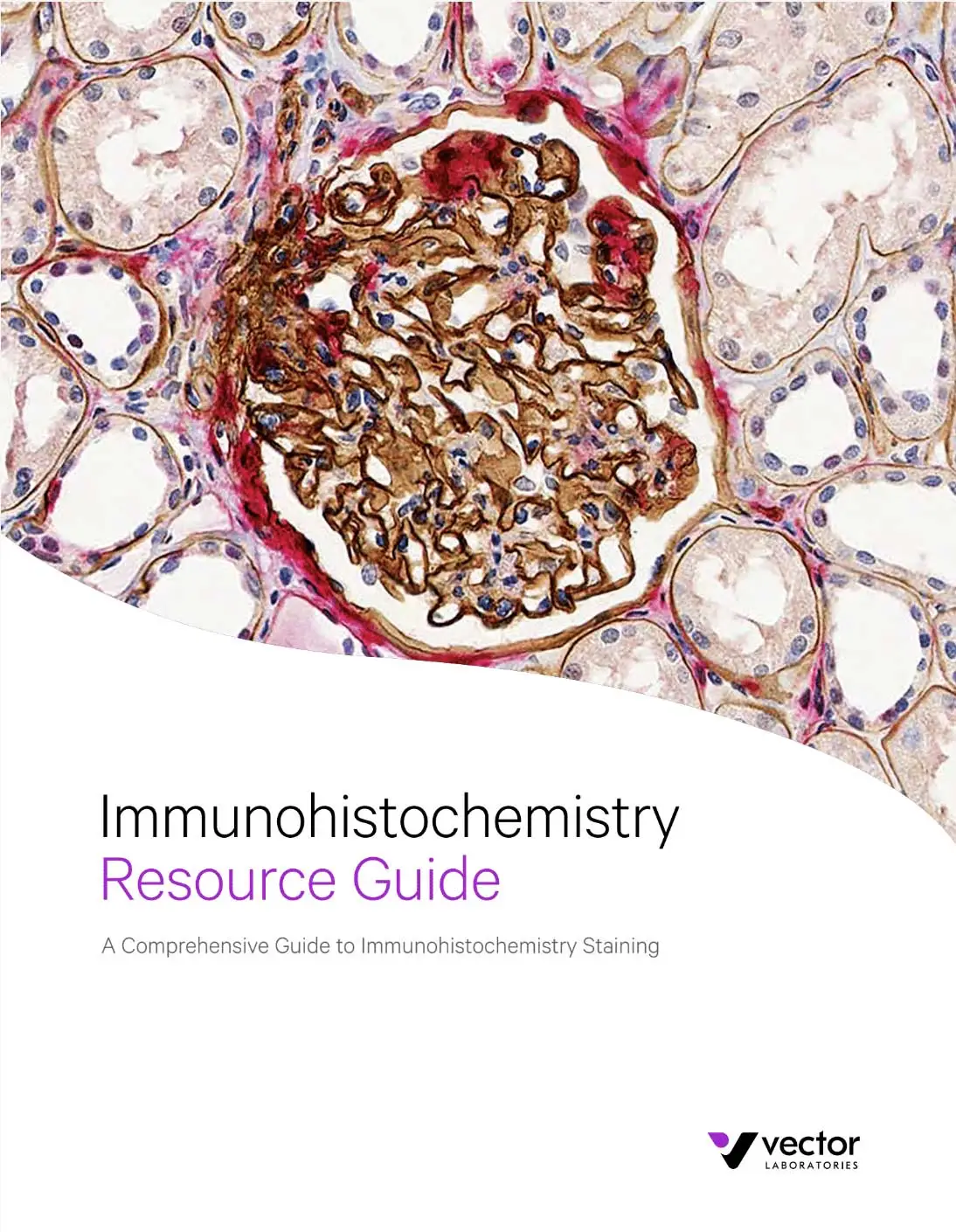Table of Contents
- Introduction
- Immunohistochemistry Workflow
- Immunohistochemistry Selection Guide
- Pioneering in IHC Technology
- Choosing a Detection System
- Avidin-Biotin Complex (ABC)-Based Detection
- VECTASTAIN® ABC Systems
- VECTASTAIN® ABC Kits
- Choosing a VECTASTAIN® ABC Kit
- > Customizing your VECTASTAIN® ABC Kit
- Polymer-Based Detection
- ImmPRESS® One-Step Polymer Systems
- > ImmPRESS® Two-Step Amplified Polymer Systems
- > Choosing an ImmPRESS® Polymer Kit
- > Multiple Antigen Labeling Simplified
- Species on Species Detection
- M.O.M.® (Mouse on Mouse) Immunodetection Kits
- Choosing an Enzyme Substrate
- Enzyme Substrates
- > Enzyme Substrate Properties
- Multiple Antigen Labeling
- Enzyme Substrate Combinations
- Counterstaining
- > Counterstain/Substrate Compatibility Table
- Blocking Background Signal
- Secondary and Tertiary Detection Reagents
- Mounting Media
- Accessory Reagents
- Introduction
- Immunohistochemistry Workflow
- Immunohistochemistry Selection Guide
- Pioneering in IHC Technology
- Choosing a Detection System
- Avidin-Biotin Complex (ABC)-Based Detection
- VECTASTAIN® ABC Systems
- VECTASTAIN® ABC Kits
- Choosing a VECTASTAIN® ABC Kit
- > Customizing your VECTASTAIN® ABC Kit
- Polymer-Based Detection
- ImmPRESS® One-Step Polymer Systems
- > ImmPRESS® Two-Step Amplified Polymer Systems
- > Choosing an ImmPRESS® Polymer Kit
- > Multiple Antigen Labeling Simplified
- Species on Species Detection
- M.O.M.® (Mouse on Mouse) Immunodetection Kits
- Choosing an Enzyme Substrate
- Enzyme Substrates
- > Enzyme Substrate Properties
- Multiple Antigen Labeling
- Enzyme Substrate Combinations
- Counterstaining
- > Counterstain/Substrate Compatibility Table
- Blocking Background Signal
- Secondary and Tertiary Detection Reagents
- Mounting Media
- Accessory Reagents
Choosing a Detection System
Immunohistochemistry Overview
Immunohistochemistry (IHC) is a method to detect specific target antigens (proteins) in tissue sections using antibodies. Immunocytochemistry (ICC) uses similar techniques to localize cellular proteins in cell preparations. Both IHC and ICC are powerful tools that provide insights into gene expression, spatial relationships, and biomarker identification in a wide variety of applications. These applications include basic research, assessment of normal and disease states within human and animal tissues, and assessment of plant pathology.
The target antigen, bound by the detection antibody, is visualized using either chromogenic or fluorescence detection. In chromogenic detection, the detection antibody is conjugated to an enzyme. The enzyme, usually horseradish peroxidase or alkaline phosphatase, catalyzes the conversion of its respective chromogen to a colored precipitate at the site of the antigen. This precipitate can be visualized by using brightfield microscopy. Certain chromogens can also be visualized by using electron, darkfield or fluorescence microscopy. In fluorescence detection, the detection antibody is conjugated to a fluorophore which can be visualized using fluorescence microscopy.
For the purposes of this antibody selection guide, IHC will be referenced for both IHC and ICC techniques.
Comparison of Detection Systems and Antibody Selection
Choose the appropriate detection system for your experiment based on enzyme, sensitivity, cost, biotin vs. non-biotin formats, flexibility, and time considerations. These parameters will help you with your antibody selection.
| Detection System | Enzyme | Sensitivity | Cost/ Assay | Biotin- Free | Micro- polymer | Modular | Mouse Primary on Mouse Tissue | Ready-to- Use (R.T.U.) Format | Typical number of steps |
|---|---|---|---|---|---|---|---|---|---|
| ImmPRESS® Kits | |||||||||
| ImmPRESS® Excel Amplified HRP Polymer Kits | HRP |
•••••• |
•••• |
• |
• |
|
|
• |
2 |
| ImmPRESS® HRP Polymer Kits | HRP |
••••• |
••• |
• |
• |
|
|
• |
1 |
| ImmPRESS® VR HRP Polymer Kits | HRP |
••••• |
•••• |
• |
• |
|
|
• |
1 |
| ImmPRESS® AP Polymer Kits | AP |
••••• |
•••• |
• |
• |
|
|
• |
1 |
|
VECTASTAIN® Kits |
|||||||||
| VECTASTAIN® Elite® ABC Kits | HRP |
••••• |
•• |
|
|
• |
|
|
2 |
| R.T.U. VECTASTAIN® Elite® Kits | HRP |
••••• |
•• |
|
|
• |
|
• |
2 |
| VECTASTAIN® Universal Quick Kits | HRP |
•••• |
•• |
|
|
• |
|
|
2 |
| R.T.U. VECTASTAIN® Universal Quick Kits | HRP |
•••• |
•• |
|
|
• |
|
• |
2 |
| VECTASTAIN® ABC-AP Kits | AP |
•••• |
• |
|
|
• |
|
|
2 |
| Original VECTASTAIN® ABC Kits | HRP |
••• |
• |
|
|
• |
|
|
2 |
| M.O.M.® (Mouse on Mouse) Kits | |||||||||
| M.O.M.® (Mouse on Mouse) ImmPRESS® Polymer Kit | HRP |
••• |
••• |
• |
• |
|
• |
|
1 |
| M.O.M.® (Mouse on Mouse) Kits | HRP |
••• |
••• |
|
|
• |
• |
|
2 |
| Additional Options | |||||||||
| Enzyme Conjugated Avidin/Streptavidin | HRP or AP |
••• |
• |
|
|
• |
|
|
2 |
| R.T.U. HRP Avidin/Streptavidin | HRP |
••• |
• |
|
|
• |
|
• |
2 |
| Enzyme Conjugated Secondary Antibody | HRP or AP |
•• |
• |
• |
|
|
|
|
1 |
HRP – Horseradish peroxidase
AP – Alkaline phosphatase
VR – Veterinary Reagents


